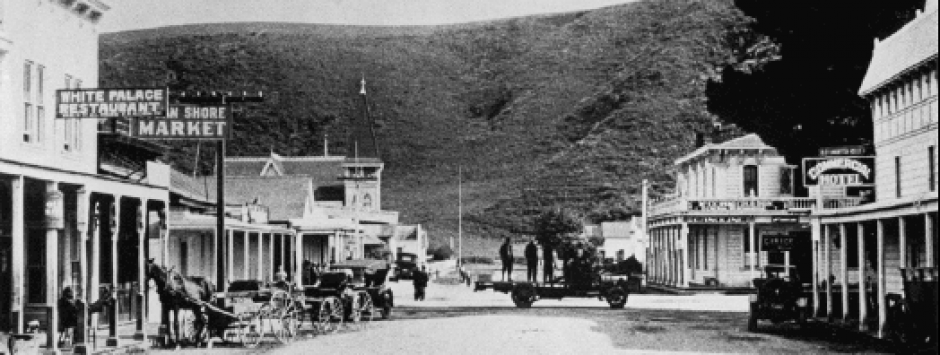Meta
Recent Comments
- Dave Olson on About June Morrall
- Gerd Gunkel on About June Morrall
- Ed Holloway on About June Morrall
Categories
- "Mountain" Mike Merritt (6)
- "The Loop" (1)
- A La California: Sketches of Life in the Golden State (3)
- Acid Beach (5)
- Alexander Moore (1)
- AM Parker (2)
- AMB Beach (3)
- Angelo Misthos (5)
- Ano Nuevo (22)
- Ano Nuevo Island (1)
- Ano Nuevo lighthouse (1)
- Arches (3)
- Ashaleigh Parker (2)
- Atlantis Rising (1)
- Bathhouse Rock (1)
- Beach Clean-Up (2)
- Bean Hollow (2)
- Beat Museum (1)
- Bideawee (1)
- Bob Dougherty (1)
- Bobbi Ballard Pimentel (2)
- Buoys (1)
- Burney J. Le Boeuf (1)
- Burt Blumert (1)
- California Coastal Records Project (1)
- California Newspaper Project (1)
- California State Auto Association (1)
- Carrier Pigeon Point (2)
- Cascade Ranch Dairy (2)
- Charles Clark (1)
- Charles F. Humphrey (1)
- Charles Jones (1)
- Charles Swanton (1)
- Chicken's Roost (1)
- clusters (2)
- Coast Survey Maps (1)
- Coastside Arches (2)
- Coastside Beaches (1)
- Coastside Caves (1)
- Coastside Secret Beaches (5)
- Coastside Waterfalls (1)
- Coburn Mystery (14)
- Coburn Troley Co. (1)
- Colombia (4)
- Colonel Albert S. Evans (4)
- Colonel Zig Zag (1)
- Connie Morgan (1)
- Coya British Bark (1)
- Dan Mosier (1)
- Daniel Boone (1)
- Daniel Durigan (1)
- Dave Cline (1)
- Dave Holleman (1)
- Davenport (2)
- David Gremard Romero (1)
- Downey Harvey (1)
- Dr. Alan Brown (2)
- Dr. Carl Djerassi (1)
- Dr. Isaac Goodspeed (1)
- Dr. W. J. Marsh (1)
- Duarte's Tavern (1)
- Eadweard Muybridge (1)
- Edward Mullen (2)
- Eli D. Moore (2)
- Ezra Pound (1)
- Fireman Collins (1)
- Forget-Me-Not Barkentine (1)
- Fourth of July (1)
- Franklin Point (2)
- Fremont Older (1)
- Friends of the Calamari (1)
- Galen Wolf (1)
- Gary Gates & Friends (1)
- Gazos Creek (6)
- Geocaching (1)
- Ghost Net (1)
- Giant Limpets (1)
- gooseneck barnacles (1)
- Gordon's Chute (3)
- Guadalupe Fur Seal (1)
- Harvey Mowry (3)
- Hellespoint Shipwreck (1)
- Hen Frigates (2)
- Henry Blomquist (1)
- Henry Cowell (1)
- Historic Bottles (1)
- Hole in the Wall (2)
- Holes in Pescadero (1)
- Ida J. Steele (1)
- Invisible Beach (12)
- Isaac Graham (1)
- J. W.Seaver (1)
- Jan "the beeman" Snyder (1)
- Jane Schlager (1)
- Janet Creelman (1)
- Jerry Cimino (1)
- Jim Denevan (1)
- Jo Lysowsky (1)
- Joan Druett (2)
- JoAnn Semones (2)
- Joaquin Miller (1)
- Joel Bratman (2)
- John McCormick (1)
- John Morrall (1)
- John Schamle (1)
- John Vonderlin (171)
- Jon Boxerman (1)
- Josiah P. Ames (1)
- Judge Horace Templeton (1)
- Judge James T. O'Keefe (1)
- June Morrall (6)
- Kathy Duarte (1)
- Ken Fisher (1)
- Ken Kesey (6)
- Kings Mountain (1)
- Kristina Schmale (1)
- La Honda (6)
- Lake Lucerne (1)
- Larry (1)
- Larry Fitterer (8)
- Larry Witham (1)
- Laura Wall Taylor (1)
- Leah Lubin (1)
- Lemuel Coburn (1)
- Levy Brothers (7)
- Linda Wyatt Iacono (1)
- Lizzie McCormick (4)
- Lobitos (2)
- Loma Mar (1)
- Loren Coburn (3)
- Lou Denny Wayne (2)
- Mammoth Rocks (1)
- Manuel Chorro (1)
- Marty McCormick (1)
- Mary Florey (1)
- Merrill Bickford (2)
- Message in a bottle (1)
- Michael Bowen (1)
- Michael Head (1)
- Mike Merritt (2)
- Minot Judson (1)
- Molly Ramolla (1)
- Monty Parker (8)
- Myrtle Garavanta (1)
- Mystic Cowboy (1)
- Neal Cassady (1)
- Neptune's Vomitorium (6)
- Notrocks (1)
- Nunziati Dam (1)
- Ocean Shore Railroad (7)
- Oil (4)
- Omar N. Steele (3)
- Orril Fluharty (4)
- Orrin Brown (1)
- Outstandinginthefield (1)
- Pacific City/Coyote Point (1)
- Pacific Mail Carrier Peru (1)
- Palmer Gulch Trestle (1)
- Pebble Beach Hotel (2)
- Pebble Beach Poetry (1)
- Pescadero (26)
- Pescadero Architecture (3)
- Pescadero Hgh School (1)
- Pescadero Historical Society (2)
- Pescadero Oral History Project (1)
- Pescadero Trivia (1)
- Pescadero's Pebble Beach Hotel (3)
- Pigeon Point (3)
- Pigeon Point Lighthouse (13)
- Place Names of San Mateo County (2)
- Pomponio (2)
- Pomponio Creek (1)
- Princeton-by-the-Sea (1)
- Prohibition (6)
- Purisima Falls (2)
- Purple People Eaters (1)
- Pyramids (2)
- Ralph E. Wall (1)
- Redwood Trees (2)
- Rennesselear Steele (1)
- Richard Ledford (2)
- Rob Tillitz (2)
- Robin Caldwell (3)
- Ron Duarte (2)
- Russell Towle (23)
- Samuel Bean (1)
- San Francisco Call (1)
- San Gregorio (3)
- San Juan (3)
- San Mateo County History Museum (1)
- Sarah Coburn (1)
- Sarah Swanton (1)
- Sawmills (1)
- Sea Monster (1)
- Sea Serpents (1)
- Shawn Mann (1)
- Sheri Martinelli (2)
- Sir John Franklin (1)
- Smuggler's Cove (1)
- Snails (1)
- South Coast beaches (6)
- South Coast Brick (1)
- South Coast Tunnels (4)
- Spaulding Corner (1)
- SS Fremont (1)
- Stacy Trevenon (1)
- Steele Family (6)
- Storm 1998 (1)
- Susan Friedman (3)
- Swanton House (1)
- Tafoni (1)
- Tarballs (1)
- Terry Adams (3)
- Tess Black (3)
- The Butano (7)
- The Contender (4)
- The Gazos (1)
- The Notch (1)
- The Pollocks (1)
- The Quest (3)
- The Seven Sisters (1)
- The Wrack (2)
- Thomas Butwell (1)
- Tires (2)
- Tom Butwell (1)
- Torquay (2)
- Trefiret Beach (1)
- Tunitas Creek (9)
- Uncategorized (412)
- Upenuf Road (1)
- Vanishing Beaches (1)
- Vulcan's Donut (1)
- Wadell Beach Bypass (1)
- Warm Water Lagoon (4)
- Whale Fall (1)
- Whale Watching (1)
- whaling (2)
- William Steele (1)
- Willowside Dairy (2)
- WJ Savage (1)
- Worm Farm (2)
- WWII Coastside (2)
Back then shipwrecks were fun because there was so much good stuff to take home!
Story from John Vonderlin
Email John ([email protected])
Hi June,
I’ve attached the ScreenShots from an article entitled “Our Shipwrecks,” that lists the shipwrecks of the San Francisco Bay Area and local coast from 1849 to 1869, The article appeared in the January 20, 1870 issue of “The Daily Alta.” I thought you might like this for your records. Enjoy. John
Posted in Uncategorized
Comments Off on Back then shipwrecks were fun because there was so much good stuff to take home!
John Vonderlin asks: More Pomponio Stories?
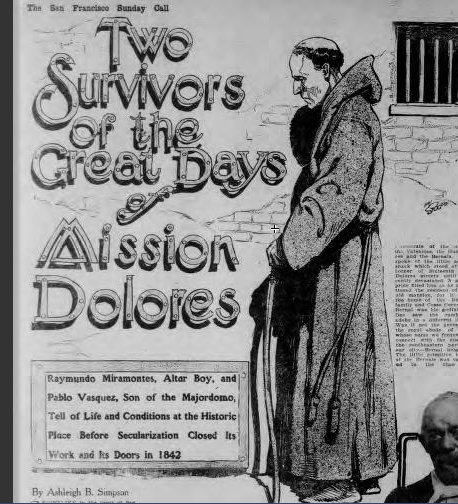
Story by John Vonderlin
Email John: [email protected]
Hi June,
While reviewing my Pomponio info for the “explosives” question, I ran into this story that I had grabbed a reminder of, but not followed through with a full set of ScreenShots, because it wasn’t “coasty” enough beyond its Pomponio reference. I see you have a lot of good Pomponio stuff, is this story familiar? If not, I’ll send the old guy’s Pomponio stories if you’d like. Enjoy. John
June to John: YES! More Pomponio stories, please. So strange that someone would name a ” renegade: Indian, Pomponio, after a creek. One of those mix-ups, I guess? Personally, I love it.
Posted in Uncategorized
Comments Off on John Vonderlin asks: More Pomponio Stories?
The Shame of the Red X’s
What is a Red X?
A Red X seems to appear when a photo doesn’t. I have a mac; John has something else.
He sends wonderful images and sometimes, too often, they refuse to cooperate and we get RED X’s.
What does that mean? Ok, my dumb, help me out you who know.
——-
P.S. I am also having trouble tapping the correct keys on the keyboard, and I think that’s because I’m still recovering from my recent loss. Burt, to be specific. Nothing works right. My whole body has gone through a big change and is trying to find its way back and part of that is learning to tap the right key to spell the word right. Don’t hesitate to email [email protected] to make the correction.
Posted in Uncategorized
Comments Off on The Shame of the Red X’s
Dominic asks: What is the odd cement bunker I saw?
Story by Dominic Lelli
Hi June from Dominic
A number of years ago 10-15 with a few classmates we decided to fish a pond at top of Pomponio Creek we had found on map.We parked on side of Pescadero Rd. near the C0unty park. We hiked NE through overgrown canyon up to ridge.Half way to ridge we reached a building 12×20 concrete with open concrete door on exterior of one side in old paint “danger explosives magazine”if you can’t shed light on past I will have to see if it’s still there before anyone else stumbles on odd cement bunker. In advance Thank You
Regards,
Dominic Lelli
Dominic Lelli
P.S Who can I contact to get more info on Spanish town Historical Group I left message on voice mail that was listed as phone contact never recvd. call back . Again Thanks for all your efforts I enjoy your site and books
———-
June: I asked John Vonderlin to answer the first part of Dominic’s question. I dealt with the second part.
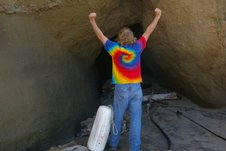
Story by John “vonderin’]
Email John ([email protected])
John Vonderlin to June and Dominic:
Hi June,
It’s a pretty safe bet that it was an explosives storage building. I’ll hunt down an article I have about a fire destroying several mills in the area. They would have all used dynamite.
I’ve attached a Coastsider weblink to a story about POST buying development rights from the Arata family. I bet POST did a full resources analysis before they put up almost 5 million just to keep the two square mile ranch from being developed. In the web article they talk about the Arata brothers, both in their eighties. I bet they would know.
Meg and I took the Pomponio trail towards Mt. Ellen a while ago. That may be the trail he took. I’m waiting for her input as she lives right across Pescadero Creek from where he started. Great question about a relatively unknown area of the Coastside that is slowly opening up as Mid-Pen and POST buy up the old farms. Enjoy. John
————————
 Hi June, and Dominic
Hi June, and Dominic I’ve attached a couple of ScreenShots from Google Earth
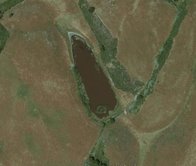
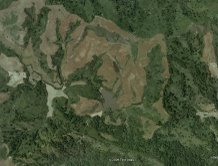
of what I believe is Arata Pond. I’m assuming the larger body of water, just south of Arata Pond in the overview picture, is the Pomponio Reservoir. Perhaps, the emailer can verify that we are talking about the same place.
I had no idea we were that close to the Pomponio watershed on the hike I mentioned. If the map shows the area where the building is/was perhaps he could describe its position in relationship to the pond and reservoir. I wouldn’t mind taking some pictures if it has any historic circumstances. I’d be glad to put it on my list. Enjoy.
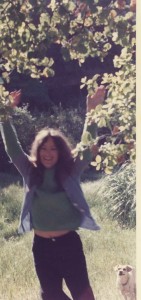
June to Dominic:
Here are a few ideas that may lead to new ideas:
the San Mateo County Museum has Spanishtown history, photos, documents. There is a local historian in HMB but I don’t her name. She may work for the City of Half Moon Bay
Hard line for the big Redwood City county museum is 650-299-0104. The museum’s archivist/librarians i Carol Peteson
On my halfmoonbaymemories.com site there are many articles related to Spanishtown, the early name for Half Moon Bay;, it’s just not organized because of the way I work.
Also, there is a walking tour of HMB, an orange colored pamphlet that may still be available. You might find a copy a Bay Book in HMB.The bookstore is located in the Strawflower Shopping Center.
And there’s my HMB Memories book in the library (maybe) and another by Kathryn Guiltier (sp) and an Arcadia book that has not been highly praised. I would go with Kathryn’s book and the tour book of HMB and what the museum has been offered.
Dominic, let us know what happens!
Posted in Uncategorized
Comments Off on Dominic asks: What is the odd cement bunker I saw?
June 1919: Coburn Murder Still A Mystery
[Image of millionaire Pescadero landowner Loren Coburn]
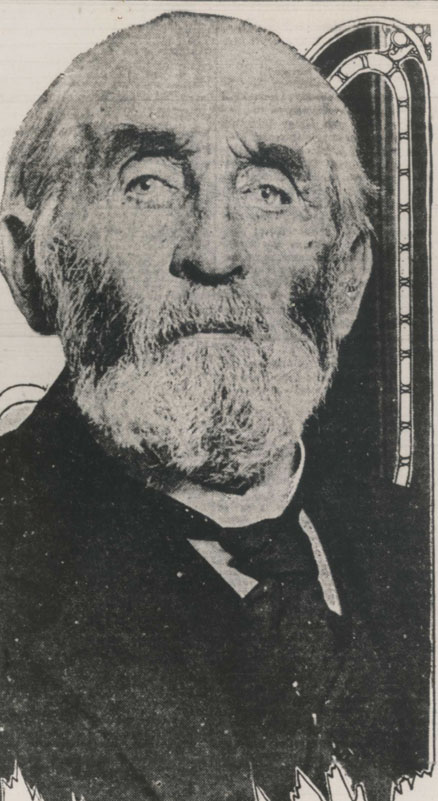
From the Coastside Comet
“Dr. W. A. Brook, as public administrator of San Mateo county, Monday, through Ross & Ross, attorneys, filed a petition for special letters of administration in the state of Mrs. Sarah Satira Coburn, brutally slain at her Pescadero home last week. According to the petition, Mrs. Coburn left an estate valued in excess of $100,000, and a will in which in which some of her relatives are overlooked.
“Mrs. Coburn’s will, disposing of her share of the Coburn estate, appraised at about $375,000 made bequests as follows: to the feeble-minded son, Wallace Loren, $50,000; to Mrs. Margaret Harrison, her companion for a year $2500; to Mrs. E.A. Eaton, friend, $2500; to Mrs. E.A. Eaton, friend $5000; so Attorney John McNab of San Francisco, $1,000a and the balance between Judge Bardin of Monterey and C. Widemann, lessee of the Coburn holdings. The reported mysterious disappearance of the club of wood with which Mrs. Coburn was murdered , and which is the most tangible clue the authorities have to work on, was cleared up Monday when it became known that Sheriff Michael Sheehan had possession of the death weapon.
“All day Sunday auoists halted at Pescadero to view the little eight-room house in which the Coburns lived and died. Half a dozen private sleuths continue their investigations and report in the best detective manner, that there is “nothing new for publication.”
“In the meantime speculation continues rift on who murdered the wealthy widow, with the majority vehement in their belief that Wallace Loren Coburn, the demented stepson, had nothing whatever to do with it.
“For the first time in forty-five years, according to Sheriff Sheehan, Wallace Loren Coburn, the stepson, was given a haircut last Saturday at a barber shop. Coburn fought against being placed in the chair, but afterward seemed to enjoy the experience. He was also dressed in his first new suit of clothes in nearly half a century. He has had his hair cut by his stepmother or his mother, and has worn the castoff clothing of his late father, Loren Coburn [who died during the 1919 Influenza Pandemic]
“From the Gardiner Sanitarium at Belmont, where the mad man is being kept, come reports that during the past few days, Wallace has repeatedly mumbled threats against well known residents of the coastside.”
Posted in Uncategorized
Comments Off on June 1919: Coburn Murder Still A Mystery
1905: John Vonderlin: Whoever has the Road has the Power (Political, I mean)
Story from John Vonderlin
Email John ([email protected])
Hi June,
Here’s an interesting fork in the road
in the history of Half Moon Bay’s development.
This story is from the May 11th, 1905 issue of
the “San Francisco Call.” It sounds like San
Gregorio’s chance to be a thriving town was
crushed by agitators in HalfMoon Bay intent
on maintaining their coastal primacy. They’re
probably still thankful.
Is this the eventual Highway 92? Enjoy. John
MAY CONSTRUCT A WAGON ROAD
Residents of HalfMoon Bay
Discuss Advisability of
Tapping La Honda District
WOULD INCREASE TRADE
Funds To Carry Out Work
Could Be Easily Raised
By Private Subscriptions
HALFMOON. BAY, May. 10.—An im –
portant agitation has been started here
for the construction of a wagon road
which will tap the rich La Honda
district and divert to this town much
of the valuable traffic and trade that is
portant agitation has been started here
for the construction of a wagon road
which will tap the rich La Honda
district and divert to this town much
of the valuable traffic and trade that is
now monopolized by Redwood City and
Palo Alto. In and around La Honda a
very profitable trade has developed
from the presence of many hundreds
of summer visitors and the prospect
of a coastwise railroad has made the
Palo Alto. In and around La Honda a
very profitable trade has developed
from the presence of many hundreds
of summer visitors and the prospect
of a coastwise railroad has made the
possibilities for traffic many times
greater. It is to take advantage of’ this
traffic that the construction of a wagon
road is being urged.
greater. It is to take advantage of’ this
traffic that the construction of a wagon
road is being urged.
A wagon road constructed from Half –
moon .Bay five miles to the east, to
connect with the county road would
make all of the traffic tributary to this
town. Such a road was surveyed many
years ago and can be built on a 4.per
cent grade. It is argued that if the
county road funds be not sufficient or
available, private subscriptions should
be raised at once to begin the highway.
At present Redwood City and Palo
Alto on the north and San Gregorio on
the south have good roads into La
Honda and reap the natural fruits of
such an advantage. When the railroad
becomes a reality it is feared that San
Gregorio will not only obtain its share
of the resulting traffic, but will absorb
that which should belong to Halfmoon
Bay. Such an event would be a very
serious one for Halfmoon Bay, as at a
single stroke it would lose its primacy
among the coast towns of San Mateo
County. A wagon road such as that
now being discussed would prevent any
change of existing conditions.
moon .Bay five miles to the east, to
connect with the county road would
make all of the traffic tributary to this
town. Such a road was surveyed many
years ago and can be built on a 4.per
cent grade. It is argued that if the
county road funds be not sufficient or
available, private subscriptions should
be raised at once to begin the highway.
At present Redwood City and Palo
Alto on the north and San Gregorio on
the south have good roads into La
Honda and reap the natural fruits of
such an advantage. When the railroad
becomes a reality it is feared that San
Gregorio will not only obtain its share
of the resulting traffic, but will absorb
that which should belong to Halfmoon
Bay. Such an event would be a very
serious one for Halfmoon Bay, as at a
single stroke it would lose its primacy
among the coast towns of San Mateo
County. A wagon road such as that
now being discussed would prevent any
change of existing conditions.
Posted in Uncategorized
Comments Off on 1905: John Vonderlin: Whoever has the Road has the Power (Political, I mean)
Old Town, Kinnear & Pat Avila…Ring any Seashells ?
Storty from John Vonderlin’
Email John ([email protected](SE
i June, This page I've attached ScreenShots of popped up when I was researching Gordon's Chute (not a lot out there). It's a geocities webpage. I've not been able to find out much about the Kinnear who is mentioned here. He was Scottish, named Ebeneezer, came here in 1868, and his son(?) John was a Coastside businessman after him. I'd like to know what this page is from, as it has some great stuff. Are you familiar with Pat Avila? Was the blacksmith shop rebuilt? Enjoy. John |
2 attachments — Download all attachments View all images
| ScreenShot3541.jpg 298K View Download |
| ScreenShot3542.jpg 244K View Download |
Posted in Uncategorized
Comments Off on Old Town, Kinnear & Pat Avila…Ring any Seashells ?
1908: And the winner is….the guy who walked to Santa Cruz….
Story from John Vonderlin
Email John ([email protected])
AND THE WINNING STORY IS: A WALK TO SANTA CRUZ
Hi June,
This might be my new favorite travelogue to the Coastside. It reminds me of some ill-fated trips into the wilderness I had when I was a young man. This is only one of the numerous interesting vacation stories on the “Junior Call” page (#2) of the October 17, 1908 issue of the San Francisco Call. Six watches were awarded for the best stories. This one is about a young man and his brother’s walking trip from San Mateo to Santa Cruz.
THE WALK TO SANTA CRUZ
ALFRED MATSON,
502 Clayton Street, San Francisco.
Crocker School, B Eighth Grade.
-.Age 14 Years-
It was early Saturday morning, June
28, that my brother and I started on
the long walk to Santa Cruz. We took
the car to San-Mateo, from where we
started on our real walking trip. We
reached; Redwood: by noon. Here we
had our lunch and after resting we
started toward the mountains. We
walked about two hours, when he sud –
denly came to the conclusion that we
were lost, for there were hills on all
sides of us. But, as I had noticed a
cowpath running north and south, I
suggested following it, which sugges –
tion was readily accepted by my
brother. After following this path for
about half an hour we came to a tiny
creek, which we both thought a favor –
able camping ground. Here we made
our coffee and ate our supper. I rolled
Into my blanket, but my brother wrote
in his diary. I soon went to sleep – and
awoke at dawn. I awoke my brother and then
502 Clayton Street, San Francisco.
Crocker School, B Eighth Grade.
-.Age 14 Years-
It was early Saturday morning, June
28, that my brother and I started on
the long walk to Santa Cruz. We took
the car to San-Mateo, from where we
started on our real walking trip. We
reached; Redwood: by noon. Here we
had our lunch and after resting we
started toward the mountains. We
walked about two hours, when he sud –
denly came to the conclusion that we
were lost, for there were hills on all
sides of us. But, as I had noticed a
cowpath running north and south, I
suggested following it, which sugges –
tion was readily accepted by my
brother. After following this path for
about half an hour we came to a tiny
creek, which we both thought a favor –
able camping ground. Here we made
our coffee and ate our supper. I rolled
Into my blanket, but my brother wrote
in his diary. I soon went to sleep – and
awoke at dawn. I awoke my brother and then
made coffee while my brother explored the
surrounding country. He came back
and told that there was a road to the
south of us. After breakfast we struck
out along the road and it was hard
walking, for it was all up hill. We
ate our. lunch; at a place called Upenuf.
After resting a while we started again,
but it was easier now, as it was down
hill. And now we came into the red –
wood district, where our enormous big
trees rear their black, green heads to
blue California skies. After walking
until dusk, we came to .the little town
of La Honda, where we decided to
camp for the night.
We found a good camping ground un –
der two tall redwoods. My brother and
I went to; bed early for we wanted to
reach Pescadero the next night.
surrounding country. He came back
and told that there was a road to the
south of us. After breakfast we struck
out along the road and it was hard
walking, for it was all up hill. We
ate our. lunch; at a place called Upenuf.
After resting a while we started again,
but it was easier now, as it was down
hill. And now we came into the red –
wood district, where our enormous big
trees rear their black, green heads to
blue California skies. After walking
until dusk, we came to .the little town
of La Honda, where we decided to
camp for the night.
We found a good camping ground un –
der two tall redwoods. My brother and
I went to; bed early for we wanted to
reach Pescadero the next night.
At 1 o’clock the next day; we were at
San Gregorio. Here we ate our lunch, but
soon were on our way, for Pescadero
was a good ways off. After a dry and
hot walk we reached Pescadero at
nightfall. By good luck, we found, a
favorable camping ground on a bank of
a creek. We ate a dry supper; for I,
for one, was very tired. Next morrn –
ing I found, to my dismay, that my
brother’s face was so swollen from
poison oak that he was blind. So I led
him to the doctor, who asked us how
he got it, but we didn’t know, but he
must have slept in it, for it was all
over his body. ~ He. gave us a prescription
that he said would cure him by that
night. But by night he was as bad as ever,
San Gregorio. Here we ate our lunch, but
soon were on our way, for Pescadero
was a good ways off. After a dry and
hot walk we reached Pescadero at
nightfall. By good luck, we found, a
favorable camping ground on a bank of
a creek. We ate a dry supper; for I,
for one, was very tired. Next morrn –
ing I found, to my dismay, that my
brother’s face was so swollen from
poison oak that he was blind. So I led
him to the doctor, who asked us how
he got it, but we didn’t know, but he
must have slept in it, for it was all
over his body. ~ He. gave us a prescription
that he said would cure him by that
night. But by night he was as bad as ever,
so I packed up and we went to
the hotel, where. we got a room. Next
morning we took the stage to Redwood
City, where we took the train to San
Francisco. – So ends the eventful tale of
the hike to Santa Cruz;
the hotel, where. we got a room. Next
morning we took the stage to Redwood
City, where we took the train to San
Francisco. – So ends the eventful tale of
the hike to Santa Cruz;
This contest is open to San Fran –
cisco and California juniors between
the ages of 10 and 16 years, and for
the six best stories published each
week The Junior Call awards as prizes
six handsome school watches.
For the younger Juniors, under 10
years of age, another contest is open,
particulars of which are given on the
fourth page today.
The watches awarded in this week’s
contest will be mailed in a few days.
If you are a winner and have not re –
ceived yours by next Saturday, let The
Junior Call know at once.
.
cisco and California juniors between
the ages of 10 and 16 years, and for
the six best stories published each
week The Junior Call awards as prizes
six handsome school watches.
For the younger Juniors, under 10
years of age, another contest is open,
particulars of which are given on the
fourth page today.
The watches awarded in this week’s
contest will be mailed in a few days.
If you are a winner and have not re –
ceived yours by next Saturday, let The
Junior Call know at once.
.
Posted in Uncategorized
Comments Off on 1908: And the winner is….the guy who walked to Santa Cruz….
1863: John Vonderlin Asks: Really? Icky Cobbie-Webs Over San Gregorio
Hi June,When I ran across this short article in the California Newspapers Archive, I was reminded of my first encounters with this subtle phenomena and the trouble I had convincing others I wasn’t imagining it. This report from the October 4th, 1863, issue of “The Daily Alta,” concerns a mysterious event that was reported near San Gregorio.
“A Shower of Cobwebs. — Mr. J. Shumway writes to us from Mountain View, under date of the 1st inst, (sic) that on the previous day; a shower of snbstance resembling cobwebs, fell on the San Gregorio Rancho. In some pieces there were strings 30 feet long; in others there was a little tangled mass. The sky was clear; the wind was blowing from the southeast, and the shower lasted for an hour.
Being a fan and student of the odd and exotic, I was fascinated as a youth by the writings of Charles Fort. He collected a great number of reports of anomalous events such as this and along with Robert Ripley fed my developing view of the state of reality at Nature’s fringe. His reports of the raining of various animals from the sky through the years and across the continent were amusing if seemingly dubious, even to a wide-eyed youth, who assumed most anything written in a book must be true. As it turns out “Raining Animals” (Wikipedia) is a generally accepted weather phenomena, though its mechanisms are still debated. On the other hand, this particular phenomena of “A Shower of Cobwebs” is a well-studied and well-understood subject, being called spider ballooning or kiting. When I first observed them, gobs of cobs that is, flying in front of me as I was speeding down Highway 5, north of Bakersfield, I couldn’t get anybody to believe me I wasn’t seeing things. When after unsuccessful efforts to point them out to others I pulled over and began searching for these invisible things they assumed I’d gone off the tracks as well as the road. Just as I, in triumph, held up a small tangle of webs, pulled from a tumbleweed, to show them, another mass flew through the space between us and the truth was obvious to all. Of course, I used this event for comic effect in tall tale telling for the rest of the trip. You do know of the large vampire bats in the Sierra that rangers will not tell you about because they are an Endangered Species don’t you? Enjoy. John
Here’s a short Wikipedia excerpt about Mr. Fort’s philosophy. No wonder I liked his stuff.
Charles Hoy Fort (August 6, 1874 – May 3, 1932) was an American writer and researcher into anomalous phenomena.
Jerome Clark writes that Fort was “essentially a satirist hugely skeptical of human beings – especially scientists – claims to ultimate knowledge”.[1] Clark describes Fort’s writing style as a “distinctive blend of mocking humor, penetrating insight, and calculated outrageousness”.[2]
Writer Colin Wilson describes Fort as “a patron of cranks”[3] and also argues that running through Fort’s work is “the feeling that no matter how honest scientists thinkthey are, they are still influenced by various unconscious assumptions that prevent them from attaining true objectivity. Expressed in a sentence, Fort’s principle goes something like this: People with a psychological need to believe in marvels are no more prejudiced and gullible than people with a psychological need not to believe in marvels.”[4]
Ballooning (spider)From Wikipedia, the free encyclopediaJump to: navigation, search
Ballooning is a term used for the mechanical kiting[1][2][3] that many spiders, as well as certain mites and some caterpillars use to disperse through the air. Never is an actual lighter-than-air balloon formed; the silk has form enough to react with the wind to give lift and drag enough to mechanically kite the spider; researchers prominently applied the term ballooning for such dynamic kiting where the animal’s body is the dragging anchor to the silken kite. Biologists also applied the term “balloon silk” to the threads that mechanically form the lifting and dragging system. Distinguish the mechanics from the biological literature term.
Many small spiders use silk threads for ballooning. They extrude several threads into the air and let themselves become carried away with winds—both updrafts and windward. Tiptoeing behavior occurs as a prelude to ballooning: the spider stands on raised legs with the abdomen pointed upwards. Although most rides will end a few meters later, it seems to be a common way for spiders to invade islands. Many sailors have reported that spiders have been caught in their ship’s sails, even when far from land (Heimer 1988).
It is generally thought that most spiders heavier than 1 mg are not likely to use ballooning (Suter 1999). Also, because many individuals die during ballooning, it is more unlikely that adults will do it than spiderlings. However, adult females of several social Stegodyphus species (S. dumicola and S. mimosarum), weighing more than 100 mg and with a body size of up to 14 mm, have been observed ballooning using rising thermals on hot days without wind. These spiders used tens to hundreds of silk strands, which formed a triangular sheet with a length and width of about one meter (Schneider 2001).
|
Posted in John Vonderlin, San Gregorio
Tagged John Vonderlin, San Gregorio
Comments Off on 1863: John Vonderlin Asks: Really? Icky Cobbie-Webs Over San Gregorio
John Vonderlin: Take me to the”Holy Well?”
Story from John Vonderlin
Email John ([email protected])
Hi June,
This little description of one of the Pescadero region’s
least known oddities of the mystical variety, “The Holy Well,”
is excerpted from a very futuristic article that appeared in
the April 12th, 1896 issue of “The San Francisco Call,” The
article was entitled “From The Bowels of The Earth,” and was
about well-boring, for geothermal power, for oil, for the “Center of
the Earth,” (280 years at standard rate). Mr. Hoagland, a
Red Adair kind of figure in the of well-boring industry, is quoted
extensively about his career. Amongst his stories was this one:
“In San Mateo County,” said Mr. Hoag –
land, “I drilled a well over 1000 feet in
depth, and struck salt water. Now this
was 700 feet above sea-level and about
eight or ten miles from the coast, on Tar
Creek, a tributary to the Pescadero. We
were aiming for oil at the time. The most
curious part of the outcome was that the
salt water flowed every seventh day.
Somebody styled it the Holy Well, as
there was no accounting for the phe –
nomenon.”
land, “I drilled a well over 1000 feet in
depth, and struck salt water. Now this
was 700 feet above sea-level and about
eight or ten miles from the coast, on Tar
Creek, a tributary to the Pescadero. We
were aiming for oil at the time. The most
curious part of the outcome was that the
salt water flowed every seventh day.
Somebody styled it the Holy Well, as
there was no accounting for the phe –
nomenon.”
Visiting Tar Creek has been on my list for a while,
but as friends say you usually can’t see the seepages
it derives its name from, it hasn’t risen close enough
to the top for me to make the hike. I’m thinking a picture of
the capped “Holy Well,” just might make it worth it.
Enjoy. John
Caption for the image below reads: Leakage from the Seas Is Converted into Steam at the Root of the Volcano
Posted in John Vonderlin
Tagged Add new tag, Bowels of the earth, Holy Well, John Vonderlin
Comments Off on John Vonderlin: Take me to the”Holy Well?”
